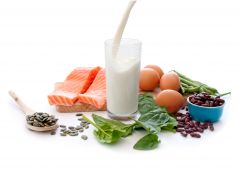Protein

What is protein?
What are proteins?
Proteins are large molecules found in our bodies and food, consisting of many smaller components called amino acids. Proteins have the properties they do because of the shape and arrangement of their amino acids. A weak bond, known as a hydrogen bond, forms between a hydrogen atom and an oxygen atom in the amino acids. This gives the protein its shape.
A protein becomes denatured when its normal shape gets deformed because some of the hydrogen bonds are broken. Hydrogen bonds break when too much heat is applied or when they are exposed to an acid (like citric acid from lemon juice). As proteins deform or unravel parts of structure that were hidden away get exposed and form bonds with other protein molecules, so they coagulate (stick together) and become insoluble in water.
Cooking by heat or acid denatures protein molecules so they are easier to digest and taste nice.
More information
BNF presentation: Protein and its functional properties in food
BNF factsheet: Food functions: Glaze
BNF experiment sheet: Testing food for protein
BNF experiment sheet: Testing food for protein 2
OCR topic exploration pack: Eggs


